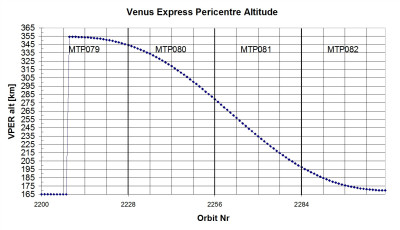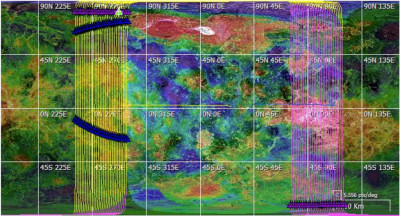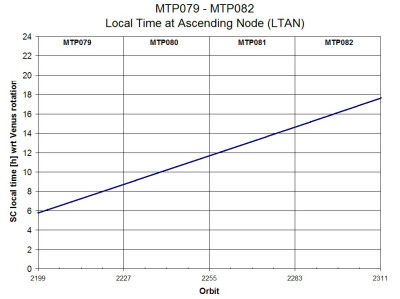No. 250 - Continuation of the thirteenth Earth occultation season, start of quadrature season, start of the ninth Atmospheric Drag Campaign, and observations of comet Machholz
Cebreros ground station
The ground system experienced considerable intermittent loss of data due to a failure in the Cebreros station Time and Frequency system on 24 July. A malfunctioning maser in the Time and Frequency system caused the loss of several data packets during the pass. All data were copied on board and subsequently downlinked, and the pass was terminated one hour earlier than planned to allow the maintenance team to solve the problem. The malfunctioning part was exchanged and there was no further impact on data recovery.
On 8 August, the Cebreros ground station experienced a malfunction in the X-Band High Power Amplifier (XHPA). To correct this, the station ground system was reconfigured to use the X-Band Low Power Amplifier (XLPA). This was done without incident, and the XLPA was used while the XHPA was repaired.
Solid State Mass Memory warm reboot
On 26 July, the Solid State Mass Memory (SSMM), the main memory bank of the spacecraft instruments and computer, experienced a problem when it tried to create a new file. Following this, it did not respond to some commands that were sent to troubleshoot the problem. This 'locking' of the SSMM occurs irregularly, but is not unusual. The SSMM was restarted without being powered off, in a process known as a warm reboot. It responded as expected, and normal operations were restored. There was no impact on data recovery except for a few data packets recorded by the magnetometer (MAG) that were lost during the execution of the reset procedure. Once completed, the normal pass activities were resumed and there was no further impact on data recovery.
In the meantime, the Flight Control Team investigated this SSMM lock-up failure and is confident of having traced the source of the problem. A minor change in SSMM operations has been implemented and the Flight Control Team has been monitoring the situation to see if the problem recurs.
DDOR High accuracy spacecraft ranging
ESA's Cebreros and New Norcia ground stations were used for a Delta Differential One-way Ranging (delta-DOR, or DDOR) measurement at the start of the Cebreros communications pass on 14 August. These measurements are carried out with the Venus Express spacecraft on a regular basis to support the accurate determination of the ephemeris for the planet Venus that is maintained by NASA's Solar System Dynamics Group.
For more information about DDOR, see the "Delta-DOR measurements" link in the right-hand column.
Start of the quadrature season
The spacecraft began operating in the outbound quadrature configuration on 7 August. The illumination conditions during quadrature makes Earth pointings 'hot' during communications periods with Earth. The spacecraft was kept in the cool orientation for a few hours to recover from these hot pointings, allowing no solar illumination on thermally sensitive faces.
For more information on quadrature operations see the link in the right-hand menu.
Ninth Atmospheric Drag Experiment campaign
Preparations for the ninth Atmospheric Experiment Campaign began on 24 July, and the ADE Campaign itself took place between 14 August and 12 September. The lowest pericentre altitude during this campaign was 170 km, and safety was not considered an issue as previous data have shown very low densities at this altitude. Six pre-ADE and three ADE measurements were carried out, and the entire campaign was executed without any problems.
 |
|
Change in Venus Express pericentre altitude (28 April to 18 August 2012). Credit: ESA |
For more information on Atmospheric Drag Experiment campaigns see the link in the right-hand menu.
Continuation of the thirteenth Earth occultation season
The thirteenth Earth occultation season continued during this period; science occultation observations were carried out over a period of 14 orbits (equivalent to 14 Earth days). The occultations occurred after the spacecraft passed pericentre, in the descending branch. Therefore, the occultation measurements were often taken immediately after and in conjunction with the ADE observations. Radio Science observations of the planet's atmosphere were carried out with the Venus Radio Science Experiment (VeRa); Spectroscopy for Investigation of Characteristics of the Atmosphere of Venus (SPICAV) and its Solar Occultation at Infrared (SOIR) channel were used to obtain information on atmospheric temperature profiles.
For more information about occultation observations, see the "Venus Express Earth occultation seasons" link in the right-hand menu.
Special operational constraints due to coincidence of quadrature, ADE campaign and occultation observations
Spacecraft activities during ADE and quadrature are normally independent specialised operations. However, between July and September 2012, these activities coincided and influenced each other with regard to scheduling, safety and science planning.
The outbound quadrature phase started on 7 August and ended on 11 September, coinciding with part of the ADE campaign. Due to the quadrature geometry, the High Gain Antennae (HGA) were swapped from HGA-2 to HGA-1 to maintain a Sun-spacecraft-Earth angle that would not violate the thermal constraints.
This ADE campaign was also coincident with an Earth occultation experiment. During these experiments, the pericentre periods are used for radio science observations that probe the Venusian atmosphere.
This was the first time that both ADE and Earth occultation observations coincided with quadrature. It was decided that no tracking would be performed by ground stations during the pericentre crossings. The pericentre tracking would have required an Earth-pointing for the ground stations to detect Doppler shifts in the downlink signal. Since these operations were taking place during quadrature, such an Earth-pointing would have been 'hot' due to the tilted attitude needed for safe quadrature operations; such a pointing would have prevented many desired science observations. Therefore, this ADE campaign only recorded the torque experiment data, and did not record the Doppler data at the ground stations.
Summary of main activities
The table below shows a chronology of the main spacecraft bus activities in the reporting period:
| Main activities during reporting period | |||
|
ADE = Atmospheric Drag Experiment; CEB = Cebreros; DOR = Differential One-way Ranging; DOY = Day of year; MET = Mission elapsed time; NNO = New Norcia |
|||
|
MET (Day) |
Date | DOY | Main Activity |
| 2448 | 22-Jul-2012 | 204 | NNO Occultation. Pre-ADE 9 torque experiment conducted. CEB communication pass. |
| 2449 | 23-Jul-2012 | 205 | CEB communication pass. |
| 2450 | 24-Jul-2012 | 206 | NNO Occultation. CEB communication pass. |
| 2451 | 25-Jul-2012 | 207 | CEB communication pass. |
| 2452 | 26-Jul-2012 | 208 | NNO Occultation. Pre-ADE 9 torque experiment conducted. CEB communication pass. |
| 2453 | 27-Jul-2012 | 209 | CEB communication pass. |
| 2454 | 28-Jul-2012 | 210 | NNO Occultation. CEB communication pass. |
| 2455 | 29-Jul-2012 | 211 | CEB communication pass. |
| 2456 | 30-Jul-2012 | 212 | NNO Occultation. Pre-ADE 9 torque experiment conducted. CEB communication pass. |
| 2457 | 31-Jul-2012 | 213 | CEB communication pass. |
| 2458 | 01-Aug-2012 | 214 | Delta-DOR with NNO performed. NNO Occultation. Pre-ADE #9 torque experiment conducted. CEB communication pass. |
| 2459 | 02-Aug-2012 | 215 | CEB communication pass. |
| 2460 | 03-Aug-2012 | 216 | NNO Occultation. CEB communication pass. |
| 2461 | 04-Aug-2012 | 217 | CEB communication pass. |
| 2462 | 05-Aug-2012 | 218 | CEB communication pass. |
| 2463 | 06-Aug-2012 | 219 | CEB communication pass. Telemetry bit rate changed to 36 kbps. |
| 2464 | 07-Aug-2012 | 220 | CEB communication pass. Quadrature Start. NNO Occultation. |
| 2465 | 08-Aug-2012 | 221 | CEB communication pass. Maintenance at Cebreros ground station - short communication pass. |
| 2466 | 09-Aug-2012 | 222 | CEB communication pass. Maintenance at Cebreros ground station - short communication pass. Pre-ADE 9 torque experiment at pericentre. NNO Occultation. |
| 2467 | 10-Aug-2012 | 223 | CEB communication pass. |
| 2468 | 11-Aug-2012 | 224 | CEB communication pass. |
| 2469 | 12-Aug-2012 | 225 | CEB communication pass. |
| 2470 | 13-Aug-2012 | 226 | Pre-ADE 9 torque experiment at pericentre. NNO Occultation. CEB communication pass. |
| 2471 | 14-Aug-2012 | 227 | CEB communication pass. |
| 2472 | 15-Aug-2012 | 228 | NNO Occultation. CEB communication pass. |
| 2473 | 16-Aug-2012 | 229 | CEB communication pass. |
| 2474 | 17-Aug-2012 | 230 | Pre-ADE 9 torque experiment at pericentre. NNO Occultation. CEB communication pass. |
| 2475 | 18-Aug-2012 | 231 | CEB communication pass. |
At the end of the reporting period on 18 August 2012, Venus Express was 109.8 million kilometres from Earth. The one-way signal travel time was 366 seconds. The final oxidizer mass was 25.652 kg and the final fuel mass was 15.876 kg.
Scientific focus
This reporting period falls under the 82nd Medium Term Plan (MTP). The thirteenth Earth occultation season, the longest of the mission, continued throughout this period and ended on 6 October. The spacecraft began operating in the outbound quadrature configuration on 7 August. The ninth Atmospheric Drag Experiment campaign started in this period, on 14 August 2012. The pericentre passes were alternated between ADE Torque measurements and VEX Radio Science (VeRa) observations.
 |
|
Venus Express coverage of Venus (22 July to 18 August 2012). |
This Medium Term Plan was considered 'hot', as pointing down at the planet nadir would expose thermally sensitive faces to the Sun, thus limiting observation times. The local time at ascending node changed from about 14.7 hours in the first orbit to about 17.6 hours in the last orbit. The illumination conditions were similar to those in Medium Term Plans 66 and 74. The downlink data rate was low, sinking to very low at the end of the period.
 |
|
Venus Express Local Time at Ascending Node (28 April to 18 August 2012). Credit: ESA |
Due to the geometry of the quadrature season, Venus was near maximum elongation from the Sun during this period - the planet was at its highest point in Earth's night sky. This means that ground-based observations of Venus were less affected by the turbulence of Earth's atmosphere than when the planet is closer to the horizon. This geometry is of interest to ground-based observers who may find it useful to compare their Earth-based data with that taken by Venus Express during the same period.
Observations of comet Machholz
The SPICAV (Spectroscopy for Investigation of Characteristics of the Atmosphere of Venus) spectrometer team obtained observations of comet Machholz while at apocentre on 22, 23 and 24 July. Measurements were carried out at the Lyman-alpha frequency in order to detect the extent of hydrogen gas clouds around the planet.
Payload activities
| ASPERA |
The instrument was regularly operated nominally as part of the routine plan.
On 24 July, during an observation with ASPERA, the on-board Data Management System (DMS) received a packet with the wrong length. In response, it aborted communication with ASPERA, thus losing the rest of the observation. This is a known sporadic occurrence; subsequent observations were nominal. On 30 July, an ASPERA command was left in an unknown verification state in the command history and was not executed. All subsequent ASPERA commands of the observation were not executed and no telemetry or science data were generated. The instrument appears to have gone into safe mode. During Earth communication, the instrument was powered off again according to procedure. All following ASPERA activations and observations were successfully executed as planned. On 7 August at 10:19:22 UTC, an ASPERA data processing unit crossed its low temperature limit. This is a known issue that occurs during activation of the instrument while the spacecraft is in quadrature. To remedy this and avoid excessively cold temperatures, apocentre observations were manually disabled during quadrature by the Flight Control Team. |
| MAG | The instrument was regularly operated nominally as part of the routine plan. |
| PFS | The instrument was not operated. |
| SPICAV | The instrument was regularly operated nominally as part of the routine plan. |
| VMC |
The instrument was regularly operated nominally as part of the routine plan.
On 2, 3 and 9 August, VMC did not acknowledge a number of commands. This is a known issue, and the instrument recovered without incident. |
| VeRa | The instrument was regularly operated nominally as part of the routine plan. |
| VIRTIS | The instrument was regularly operated nominally as part of the routine plan. |
Future milestones
- Swap from HGA-2 to HGA-1, with downlink bit rate increasing to maximum
- Delta DOR test with new Malargüe ground station
- Restore batteries end-of-charge voltage to maximum in preparation for eclipse season
-
End of the thirteenth occultation season
---
Legal disclaimer
This report is based on four ESOC mission operations reports, MOR #348 through MOR #351, as well as the MTP082 Master Science Plan. Please see the copyright section of the legal disclaimer (bottom of this page) for terms of use.

